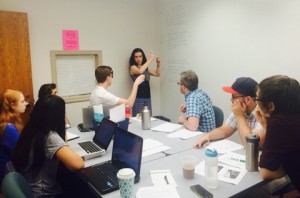SSRMC hosts Psychophysiological Methods in Political Science Workshop
In mid-July, the SSRMC hosted the first ever Psychophysiological Methods in Political Science Workshop. As one of only four active political psychophysiology labs in the country, government professor Jaime Settle’s Social Networks and Political Psychology Lab is breaking new ground in political science research. William & Mary student researchers John Stuart, Zarine Kharazian, and Edward Hernandez welcomed graduate students from Temple University, UN Lincoln, and UC Merced and W&M alumna Taylor Feenstra (currently a grad student at UC San Diego) to the three-day event to share their experiences conducting psychophysiological research and discuss strategies for moving the field forward.
One of the many challenges faced by the researchers in this area is the lack of a common set of best practices for data collection and analysis. While political scientists have long relied on self-report-based survey methodologies in their lab experiments, only recently have scholars begun collecting data through procedures derived from biological measurement. Introducing complex measurements such as electrodermal activity (EDA), photoplethysmography (PPG), electrocardiography (ECG), and electromyography (EMG) to political research questions has led to a lack of established norms for how to most efficiently gather and analyze the data. Pioneering research in an emerging field necessitates not only dealing with gaps in the existing literature, but figuring out how to address these gaps to build a strong foundation for future researchers.
At William & Mary, a major SNaPP Lab project focuses on levels of physical response, such as changes in heart rate, to visual displays of political and social contention. At UN Lincoln, John Peterson attaches equipment to subjects’ faces and measures changes in expressions—like furrowed brows—to understand internal attitudes toward political groups. At UC Merced, Chelsea Coe reevaluates the established topic of media issue framing and investigates how more physically reactive and less physically reactive individuals respond to different types of frames. Nick Anspach, at Temple University, uses psychophysiology to determine how threatened people feel when encountering descriptions of political candidates. These projects apply the novel methodologies of psychophysiology to dive more deeply into the research interests political scientists have always had. In most cases, the projects still utilize some self-report measurement. But now, this is not the only source of information researchers can use to understand a participant’s experience.
Psychophysiological methods bring to light biological differences that illustrate there is more to the story about how people interact with each other and their political environments than what can be gleaned from a Likert-scale survey. Participating in a psychophysiology experiment does not feel like participating in the political experiments of old. Subjects are hooked up to wires and electrodes, the hardware components of the BIOPAC equipment. This equipment records physiological responses of which the participants might not even be aware, but are displayed for researchers on a computer monitor in an adjoining room. The EDA electrodes record changes in skin conductivity due to the presence of sweat, a signal of the body’s stress response. The PPG sensor reveals the familiar heart beat pattern one might see at a doctor’s office, but is used to assess how different stimuli change the variability of the heart’s rhythm. These techniques reveal a “human-ness” to political behavior previously absent from the conversation.
The workshop wrapped up by asking “what comes next?” While the student attendees are currently finishing various stages of dissertations and honors theses, the group looked toward a future of collaboration. Asking questions about combining population samples, further understanding data analysis software, improving technological infrastructure, and creating a set of methodological norms, the researchers made the case for catapulting political psychophysiology into the mainstream. The field is currently floating under the radar of many traditional political scientists, but it is certainly on the right path. Some of the important early steps are being taken here, at William & Mary.



